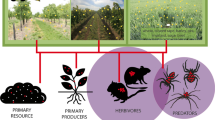Abstract
The disposition of14C-dieldrin (HEOD) was examined in a Terrestrial Microcosm Chamber (TMC) model ecosystem consisting of a synthetic soil medium, agricultural crops, numerous invertebrates and a microtine rodent. Residues were determined in air, soil, water, plants, invertebrates, and tissues of the vole (Microtus canicaudus) and her offspring. Design considerations for this experiment were (a) whether the test system satisfactorily measured the fate of the material applied, (b) whether the results were comparable to field and laboratory studies of the rates and extent of movement, transformation and biological effects of HEOD, and (c) whether the TMC was comparable to other microcosm test systems. The average accountability was 89% of the14C-dieldrin applied to three TMCs. At termination, the soil contained 55% (± 19%) of the14C, plants 30% (± 18%) and fauna 1.5% (± 0.9%). The vole exhibited an average Ecological Magnification index of 59.5. An average concentration of 17.7 ppm HEOD was noted in the vole brain. Dieldrin adversely affected both vole survival and reproductive performance.
The results in the TMC are highly consistent with the behavior of the chemical in the natural environment and in other microcosm systems.
Similar content being viewed by others
References
Beall, M. L. Jr., R. G. Nash, and P. C. Kearney: Agroecosystem—a laboratory model ecosystem to simulate agricultural field conditions for monitoring pesticides. In: Proceedings of the Conference on Environmental Modeling and Simulation, p. 790, Cincinnati, OH. (1976).
Caro, J. H., A. W. Taylor, and E. R. Lemon: Measurement of pesticide concentrations in air overlying a treated field. In: Proc. Intl. Symp. Identification and Measurement of Environmental Pollutants. p. 72, Ottawa, Ont., Canada (1971).
Cole, L. K., R. L. Metcalf, and J. R. Sanborn: Environmental fate of insecticides in terrestrial model ecosystems. Intern. J. Environmental Studies10, 7 (1976).
Farmer, W. J.: Leaching, diffusion, and sorption of benchmark pesticides. In: A Literature Survey of Benchmark Pesticides, p. 185–245. Geo. Washington Medical Center, Washington, D.C. (1976).
Gillett, J. W., and J. D. Gile: Progress and status report on terrestrial in-house system. In: Proceedings of Substitute Chemicals Program-The First Year of Progress. Vol. 3. Fredericksburg, VA: (1975).
—:, Pesticide fate in terrestrial laboratory ecosystems. Intern. J. Environmental Studies10, 15 (1976).
Harr, J. R., R. R. Claeys, J. F. Bone, and T. W. McCorkle: Dieldrin toxicosis: Rat reproduction. Amer. J. Vet. Res.31, 181 (1970).
Hathaway, D. E., J. A. Moss, J. A. Rose, and D. J. M. Williams: Transport of dieldrin from mother to blastocyst and from mother to fetus in pregnant rabbits. Europ. J. Pharmacol.1, 167 (1967).
Korschgen, L. J.: Soil-food-chain-pesticide relations in aldrin-treated fields. J. Wildlife Management34, 186 (1970).
Metcalf, R. L., G. K. Sangha, and I. P. Kapoor: Model ecosystem for evaluation of pesticide biodegradability and ecological magnification. Environ. Sci. Tech.5, 709 (1971).
Nash, R. G., M. L. Beall, Jr., and W. G. Harris: Toxaphene and 1,1,1-trichloro-2,2-bis-(p-chlorophenyl) ethane (DDT) losses from cotton in an agroecosystem chamber. J. Agric. Food Chem.25, 336 (1977).
Parmele, L. H., E. R. Lemon, and A. W. Taylor: Micrometeorological measurement of pesticide vapor flux from bare soil and corn under field conditions. Water, Air, and Soil Pollution1, 433, (1972).
Phillips, F. T.: Persistence of organochlorine insecticides on different substrates under different environmental conditions. I. The rate of loss of dieldrin and aldrin by volatilization from glass surfaces. Pestic. Sci.2, 255 (1971).
Sanborn, J. R., and C. C. Yu: The fate of dieldrin in a model ecosystem. Bull. Environ. Contam. Toxicol.10, 340 (1973).
Spencer, W. F., and M. M. Cliath: Vapor density of dieldrin. Environ. Sci. Tech.3, 670 (1969).
Spencer, W. F.: Vapor pressure and vapor losses of benchmark pesticides. In: A Literature Survey of Benchmark Pesticides, p. 72. Geo. Washington Medical Center, Washington, D.C. (1976).
Author information
Authors and Affiliations
Rights and permissions
About this article
Cite this article
Gile, J.D., Gillett, J.W. Fate of14C dieldrin in a simulated terrestrial ecosystem. Arch. Environ. Contam. Toxicol. 8, 107–124 (1979). https://doi.org/10.1007/BF01055145
Received:
Accepted:
Issue Date:
DOI: https://doi.org/10.1007/BF01055145




